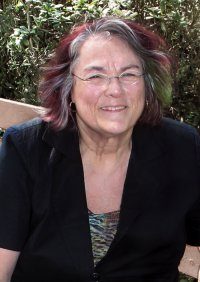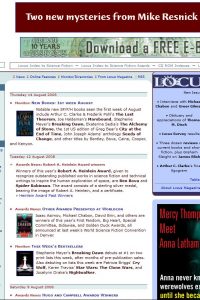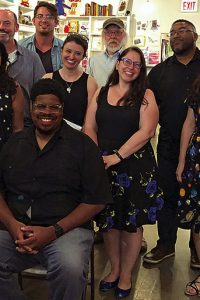Terry Bisson: Personal Alternate History
 Terry Ballantine Bisson was born February 12, 1942 in Kentucky. After attending Grinnell College in Iowa from 1960-62, and batting around LA and NY, he received a BA from the University of Louisville in 1964. In 1962, he married Deirde Holst, mother of his two sons and daughter; they divorced in 1966. From 1966-70 he lived in New York with second wife Mary Corey, scripting comics and saucer tales for tabloids and serving as editor of Web of Horror and True Intimate Confessions. He left the city to join the Red Rockers commune in the Colorado mountains (world’s largest hippy-built geodesic dome!) and other communes in the West and South while working as an auto mechanic. He returned to New York in 1976, serving as an editor and copy chief at Berkley and Ace until 1985, when he became a full-time writer. Meanwhile he was active in the John Brown Anti-Klan Committee with his current wife Judy Jensen (with whom he raised another son and two daughters). In the mid-’90s he was a consultant at HarperCollins and Avon, and taught in the writing program at The New School in New York and at Clarion and Odyssey. He and Jensen moved to the Bay Area in 2002, where he edits the ‘‘Outspoken Authors’’ series for PM Press, and hosts the SF in SF reading series.
Terry Ballantine Bisson was born February 12, 1942 in Kentucky. After attending Grinnell College in Iowa from 1960-62, and batting around LA and NY, he received a BA from the University of Louisville in 1964. In 1962, he married Deirde Holst, mother of his two sons and daughter; they divorced in 1966. From 1966-70 he lived in New York with second wife Mary Corey, scripting comics and saucer tales for tabloids and serving as editor of Web of Horror and True Intimate Confessions. He left the city to join the Red Rockers commune in the Colorado mountains (world’s largest hippy-built geodesic dome!) and other communes in the West and South while working as an auto mechanic. He returned to New York in 1976, serving as an editor and copy chief at Berkley and Ace until 1985, when he became a full-time writer. Meanwhile he was active in the John Brown Anti-Klan Committee with his current wife Judy Jensen (with whom he raised another son and two daughters). In the mid-’90s he was a consultant at HarperCollins and Avon, and taught in the writing program at The New School in New York and at Clarion and Odyssey. He and Jensen moved to the Bay Area in 2002, where he edits the ‘‘Outspoken Authors’’ series for PM Press, and hosts the SF in SF reading series.
First novel Wyrldmaker appeared in 1981, followed by World Fantasy finalist Talking Man (1986) and Fire on the Mountain (1988). Other novels include Voyage to the Red Planet (1990), Pirates of the Universe (1990), The Pickup Artist (2001), and Any Day Now (2012). He completed the late Walter M. Miller, Jr.’s Saint Leibowitz and the Wild Horse Woman (1997), and has co-written YA novels with Stephanie Spinner, written children’s books about NASCAR racing as ‘‘T.B. Calhoun,’’ produced numerous film and TV novelizations and media tie-ins, and written non-fiction titles, notably On A Move: The Story of Mumia Abu-Jamal (2001).
Bisson rose to prominence in the SF field with Hugo, Sturgeon, Locus, and Nebula Award-winning story ‘‘Bears Discover Fire’’ (1990). Other notable short stories include Hugo finalists ‘‘Press Ann’’ (1991), ‘‘The Shadow Knows’’ (1993), ‘‘Dead Man’s Curve’’ (1994), ‘‘Get Me to the Church on Time’’ (1998); Nebula Award nominees ‘‘They’re Made out of Meat’’ (1991) and ‘‘Necronauts’’ (1995); Hugo, World Fantasy, and Nebula Award finalist ‘‘England Underway’’ (1993); Nebula Award winner and Hugo and Sturgeon finalist ‘‘macs’’ (1999); and novellas Dear Abbey (2003) and Planet of Mystery (2008). His short fiction has been collected in Bears Discover Fire (1993), In the Upper Room and Other Likely Stories (2000), Numbers Don’t Lie (2003), Greetings & Other Stories (2005), Billy’s Book (2009), and TVA Baby (2011). The Left Left Behind (2009) includes the title story, a play, and an interview and autobiography.
‘‘People used to say to me, ‘You were involved in the ’60s, the counterculture, the commune scene, the anti-war movement, the New Left and all that. You should write something about it.’ My answer was, ‘Me and a million others. Plus everybody knows how it all turned out, so what’s the point?’ Then one day I thought: What if it turned out differently? Any Day Now is definitely a science fiction novel, an alternate history, even though it’s more about political than technological change. The only device in the book is the geodesic dome. It’s set in 1968, the ‘hinge of the ’60s,’ you might say (though the ’60s really started in the ’50s, the breaking wave of the postwar boom), and the ‘hinge’ of the novel is a disputed presidential succession. The idea was actually swiped from Philip Roth, who apparently never knew The Plot Against America was alternate history. He thought he invented the form!
 ‘‘Any Day Now started as an alternate history, and then took on a little more weight for me personally as the back story developed, since the protagonist (the Dorothy, if you will) starts in small-town middle America, then scoots off to college, veers through boho New York, then lands in the hippy Southwest. He’s part of the whole ’60s mix of radical politics and counterculture. I began to feel that this was the book I should write, the more personal story I usually manage to avoid. At the same time I realized it was sort of paradigmatic, not really my own story but a common, archetypal story, not just of that era but in all of Western literature: the kid goes from the boonies to the metropolis (Paris, London, New York) and flies or flops or whatever. But mostly it’s the story of a whole generation of young people. Where did 1968 come from? I got there on the same train as 150,000 others and I described the ride.”
‘‘Any Day Now started as an alternate history, and then took on a little more weight for me personally as the back story developed, since the protagonist (the Dorothy, if you will) starts in small-town middle America, then scoots off to college, veers through boho New York, then lands in the hippy Southwest. He’s part of the whole ’60s mix of radical politics and counterculture. I began to feel that this was the book I should write, the more personal story I usually manage to avoid. At the same time I realized it was sort of paradigmatic, not really my own story but a common, archetypal story, not just of that era but in all of Western literature: the kid goes from the boonies to the metropolis (Paris, London, New York) and flies or flops or whatever. But mostly it’s the story of a whole generation of young people. Where did 1968 come from? I got there on the same train as 150,000 others and I described the ride.”
…
‘‘I don’t read a lot of modern novels. I read historicals or go back and read Victorian stuff. The modern novelists I admire most are what they call ‘women’s mid-list’, where the old rules of fiction are still in play. Writers like Jane Smiley, Cecelia Holland, and Ann Tyler still have that greater level of sincerity and involvement, instead of trying to stay aloof.”
…
‘‘I’m doing quite a bit of editing for PM Press, the ‘Outspoken Authors’ series, too. We do two or three books a year, all the same format: a short story or two, a lefty or at least progressive rant, and an extended interview. Science fiction authors only. PM is a small anarchist press in Oakland, and Ramsey Kanaan, the publisher, wanted to get into SF, so I got tagged, since I have a history editing with small lefty presses.
‘‘The first book I published in the series was actually my own, The Left Left Behind, which was a satire of the Left Behind series – Christian novels about the Rapture, (which are, by the way, probably the best selling fantasy books in America today). Then I did The Lucky Strike by Kim Stanley Robinson. Of course Stan is a big name. That’s what Ramsey wanted: identifiable big names in science fiction. The third book I did was by Eleanor Arnason, who is not a big name (she’s more like me) but a heavyweight writer. Huge names like Le Guin or Moorcock were easy to work with. Ursula was great, and Moorcock was just a sweetheart, very generous with his time. I put the material together, and I also do the interviews. With Le Guin, I would ask a long question and get a short answer, but it was great! With Moorcock, all I had to do was ask a very short question, and I’d get a long, beautiful answer.”
…
‘‘I’ve also been working on movies. A fool’s errand, but hey. Two guys in Brooklyn have optioned ‘The Hole in the Hole’, a junkyard-on-the-moon story that’s about 20 years old. ‘Necronauts’, my first Playboy story, got optioned by the guys who did Reanimator, but that’s gone on for about four years and they can’t get any traction. I’ve written a few independent screenplays where I get paid, but not Hollywood (WGA) money. I did a screenplay about Paul Robeson that looks like it’s going to get made next year. To see your name in Variety is a thrill. (Variety is the Locus of Hollywood.) Have we mentioned comics? I’m also doing a script for a graphic novel version of Walter Miller’s A Canticle for Leibowitz. And hoping it finds a home. If all this sounds like fun, well, it is. Writers chase lots of dreams – like fame, fortune, immortality – that may or may not come true. But what you do get if you’re lucky, like me, is a life in literature. And that’s a great privilege.’’






